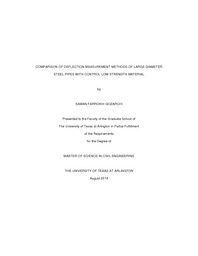
ATTENTION: The works hosted here are being migrated to a new repository that will consolidate resources, improve discoverability, and better show UTA's research impact on the global community. We will update authors as the migration progresses. Please see MavMatrix for more information.
Show simple item record
| dc.contributor.author | Farrokhi Gozarchi, Saman | en_US |
| dc.date.accessioned | 2014-07-14T20:30:58Z | |
| dc.date.available | 2014-07-14T20:30:58Z | |
| dc.date.issued | 2014-07-14 | |
| dc.date.submitted | January 2014 | en_US |
| dc.identifier.other | DISS-12736 | en_US |
| dc.identifier.uri | http://hdl.handle.net/10106/24487 | |
| dc.description.abstract | This study investigates the structural integrity of large diameter (108 inch) steel pipes with mortar lining embedded with Controlled Low Strength Material (CLSM) during installation. Field tests were carried out in the prove-out section of line J which is a 2 mile (3.21 km) section of an Integrated Pipeline network (IPL) that will ultimately run a length of 150 mile (241.4 km) from Lake Palestine to Lake Benbrook. The prove-out is a section of line J that was used for experimental research for the use of CLSM as an embedment material and calibrate Finite Element Method (FEM) model for the rest of the pipeline. The prove-out section is comprised of 11 pipes, varying in length from 24 ft. to 50 ft. (7.3-15.2 m), with a total length of 518 ft. (157.8 m). The project integrates existing Tarrant Regional Water District (TRWD) pipelines to Dallas systems to provide 350 million gallons per day (1.32 Billion liters per day) of raw water supplies to more than 1.8 million people in 11 counties in North Texas.Three methods were used to check for deflection measurements: Manuals and Reports on Engineering Practice No.119 (MOP-119) method, Laser Photo Profile and Laser Video Profile. The MOP-119 method is utilized from American Society of Civil Engineers (ASCE) Buried Flexible Steel Pipe (2009). The deflections of the steel pipes were effectively measured in each of the installation stages. The installation stages considered for this research were pipe placement, CLSM embedment at 30% pipe diameter, CLSM embedment at 70% pipe diameter, and backfill with and without stulls. Forty-three (43) sections were measured using the MOP-119 and Laser Photo Profile methods (about 12 feet or 3.65 meters a section) per installation stage. The laser video profile method was run continuously on one site visit for the entire prove-out section. The MOP-119 method was compared to the Laser Photo Profile method while stulls were present in the pipeline and later with both the Laser Photo and Video Profile method when stulls were removed. For large diameter steel pipes with mortar lining the recommended limit for deflection is set at 2% of the pipes diameter according to American Water Works Association (AWWA M11).Material tests were conducted in the Civil Engineering Laboratory Building (CELB) to check for flexural and compressive strength of CLSM based on ASTM C78/C78M-10 (Standard Test Method for Flexural Strength of Concrete) and ASTM D4832-10 (Standard Test Method for Preparation and Testing of CLSM Test Cylinders).It was observed after processing the field measurement data that the MOP-119 method yielded a higher deflection limit than the Laser Photo Profile and Laser Video Profile methods which were within the deflection limit of two percent (2%) as per AWWA specification. | en_US |
| dc.description.sponsorship | Abolmaali, Ali | en_US |
| dc.language.iso | en | en_US |
| dc.publisher | Civil & Environmental Engineering | en_US |
| dc.title | Comparison Of Deflection Measurement Methods Of Large Diameter Steel Pipes With Control Low Strength Material | en_US |
| dc.type | M.S. | en_US |
| dc.contributor.committeeChair | Abolmaali, Ali | en_US |
| dc.degree.department | Civil & Environmental Engineering | en_US |
| dc.degree.discipline | Civil & Environmental Engineering | en_US |
| dc.degree.grantor | University of Texas at Arlington | en_US |
| dc.degree.level | masters | en_US |
| dc.degree.name | M.S. | en_US |
Files in this item
- Name:
- FarrokhiGozarchi_uta_2502M_127 ...
- Size:
- 5.056Mb
- Format:
- PDF
This item appears in the following Collection(s)
Show simple item record


